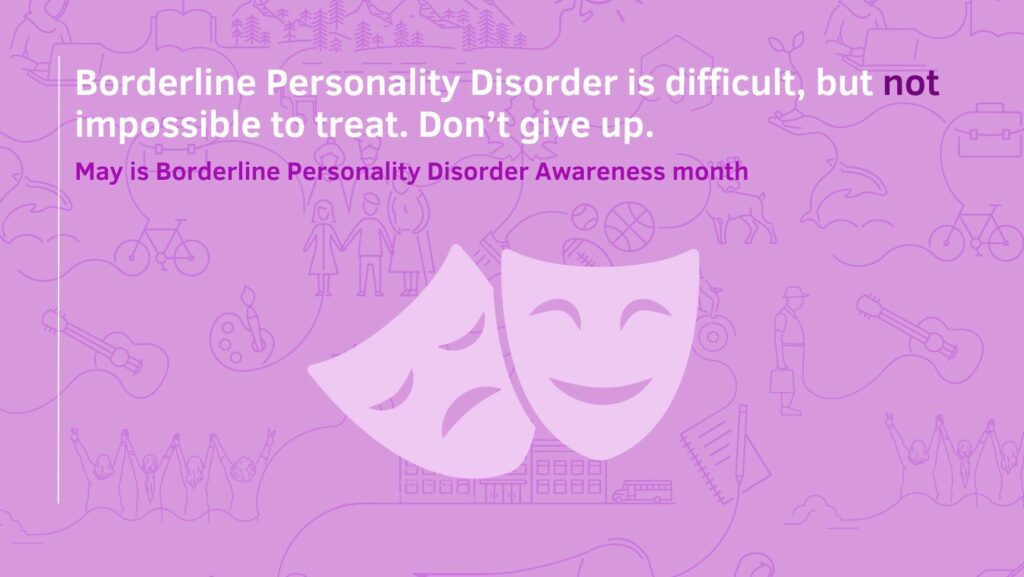Menu
Close

May is Borderline Personality Disorder Awareness month
Apr 17, 2024
Approximately 2.2 per cent of Canadians live with Borderline personality disorder (BPD).
Each person’s experience with BPD is unique, but there are some common experiences many people with BPD can relate to — like having difficult feelings toward yourself and others, instability in your relationships and your view of yourself (self-image), and periods of anger, depression, or anxiety that can last for hours to days.
People who live with BPD have difficulty regulating or handling their emotions or controlling their impulses. They are highly sensitive to what is going on around them and can react with intense emotions to small changes in their environment.
It’s also common to view things in extremes, such as only good or only bad. Many feelings and behaviors in BPD are based in a fear of abandonment or an effort to avoid being abandoned.
There’s a lot of misinformation and stigma around BPD, partly because of a historic idea that it’s untreatable — but this is not the case.
The truth is that BPD is treatable, and many people reach a point of “remission” with the help of therapy, especially dialectical behavioral therapy (DBT). This means they experience few to no BPD symptoms and may even no longer meet the criteria for BPD diagnosis.
Borderline personality disorder carries many myths and misconceptions, the most dangerous of which are that suicide threats by people with BPD are cries for attention.
These common misconceptions are harmful and lead to stigma, which can make it difficult for those who live with BPD to seek treatment.
Let’s separate fact from fiction and break down four common myths surrounding BPD.
Myth: People with BPD are manipulative and attention seeking.
You might believe the myth that people with BPD engage in manipulation and attention-seeking behaviors because they like it. Having BPD is not a comfortable situation. The condition is synonymous with stress, anxiety and unhappiness.
If someone with BPD is acting out through manipulation or appearing to seek attention, it is due to their desperation to feel well and avoid separation or rejection. Unfortunately, their unhealthy coping skills develop along the way as they cannot find the relief they seek. Lying and manipulation are only a failed attempt to control symptoms.
Myth: Suicide threats by individuals with BPD aren’t serious.
People may mistakenly see suicidal threats from someone with BPD as a way to create a reaction. Again, this assumption is untrue and unfair.
People with BPD experience a high rate of suicide. As many as 10 percent of people with BPD will die by suicide while many more will engage in suicide attempts and self-harm.
All suicide threats must be taken seriously. The risks of ignoring the threats are too high.
Myth: People with BPD are dangerous.
People with BPD are more likely to hurt themselves than anyone else.
It is true people with BPD can have periods of irritability. One of the main diagnostic criteria for BPD is an intensely, inappropriate level of anger.
People with BPD may:
- Have a bad temper or a short fuse
- Seem angry constantly
- Get into physical confrontations
This anger does not mean they are a threat to others. As mentioned, people with BPD have a high suicide rate, so they pose the greatest danger to themselves, not others.
Myth: Borderline personality disorder isn’t treatable.
Here is another dangerously incorrect myth. If people believe borderline personality disorder cannot be effectively treated, they may not seek treatment.
BPD is a complex and challenging condition. There are two keys to making BPD treatment successful:
- Evidenced-based treatments – People may offer all sorts of remedies for BPD, but if the treatment makes unrealistic promises, it might be too good to be true. Options like DBT and CBT have been proven effective. Also, medications like antidepressants and mood stabilizers are excellent choices when combined with therapy.
- Start early – To increase the chances of recovery from BPD, treatment needs to begin as soon as possible and continue for an extended period. Waiting too long to start allows the negative coping skills to become ingrained and harder to change.
Just because a condition is difficult to treat does not make treatment useless. Everyday people with BPD benefit from mental health services.
If you or someone you love have been diagnosed with BPD, please don’t lose hope, it is difficult, but not impossible to find treatment.
Here are some resources to get you started:
Resources:
- Borderline Personality Disorder: a Guide for Families
- CAMH Mental Health and Addiction 101 Series
- Borderline Personality Disorder Treatment Program (BPDTP) [Nova Scotia]
- List of NS based psychologists
- National Education Alliance for Borderline Personality Disorder (
- McLean Hospital
- NAMI
- Emotions Matter
- Families for Borderline Personality Disorder Research
- National Education Alliance for Borderline Personality Disorder
Books on Borderline Personality Disorder
- Loving Someone with Borderline Personality Disorder: How to Keep Out-of-Control Emotions from Destroying Your Relationship
- Stop Walking on Eggshells: Taking Your Life Back When Someone You Care About Has Borderline Personality Disorder
- Sometimes I Act Crazy: Living with Borderline Personality Disorder
- The Essential Family Guide to Borderline Personality Disorder
Sources: National Alliance on Mental Illness, CMHA.ca, McLean Hospital, Project 375, the Linehan Institute, psychologytoday.com